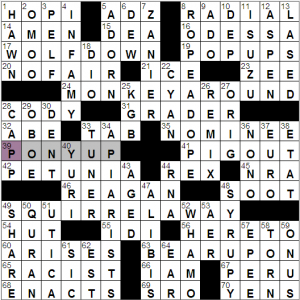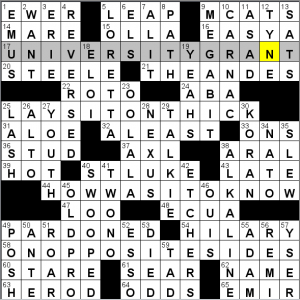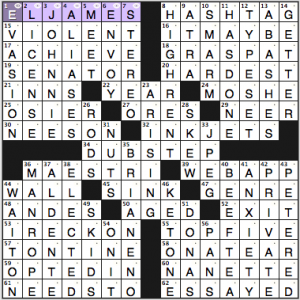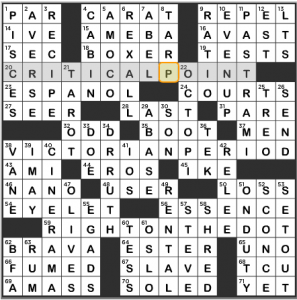NYT 3:22 (pannonica)
LAT 2:45ish
CS 4:19 (Sam)
BEQ untimed
Gareth Bain’s New York Times crossword — pannonica’s review
I very much enjoyed this puzzle, not only because of the theme but also because of the supporting content and cluing. Discerned craftsmanship throughout.
The theme is common phrases of the terse format mammal + preposition. Hence,
- 17a. [Devour] WOLF DOWN.
- 24a. [Waste time playfully] MONKEY AROUND.
- 39a. [Pay what’s due] PONY UP.
- 41a. [Eat, eat, eat] PIG OUT. Good job differentiating this clue from 17a’s. The clue for PETUNIA deftly flirts with but doesn’t commit repetition.
- 49a. [Hoard] SQUIRREL AWAY. Note that 49d is [Not hoard] SHARE.
- 63a. [Pertain to] BEAR UPON.
75% Short and sweet themers, but all six are solid. Six, all acrosses! And there’s still room for the customary longdown pair; here we have Muhammad Ali’s ROPE-A-DOPE strategy and APIARISTS, such as crossword fave ULEE (who does not appear in this puzzle, although EPEE and OMOO do (57d & 2d).
- 19a POP-UPS flirts with encroaching on the theme, but it’s a hyphenated noun, which eliminates the preposition. It does, however, strongly echo the content of 39a PONY UP.
- 65a [Like Jim Crow laws] RACIST sitting atop 68a [Makes into law] ENACTS.
- Least favorite sections: the symmetrical 3×2 areas of ADZ / DEA and IAM / SRO.
- Relatively low CAP Quotient™ though there are—practically unavoidably—some clunkers (e.g., DEP., LASED).
- Am so relieved that BTFSPLK was in a clue rather than the grid. (28d CAPP).
Really, a very fine Monday offering. And I’m not being nice because Gareth is a blogging colleague.
Martin Ashwood-Smith’s CrosSynergy/Washington Post crossword, “Sit-Ins”- Sam Donaldson’s review
Look closely at the four longest Across answers and you’ll see the letter sequence S-I-T hidden within each one:”
- 17-Across: A UNIVERSITY GRANT is one source of [College funds].
- 25-Across: One who [Flatters excessively] really LAYS IT ON THICK.
- 44-Across: A [Relative of “You can’t blame me!”] is HOW WAS I TO KNOW?
- 58-Across: To be [Like enemies] is to be on OPPOSITE SIDES.
A 72-word grid is suitable for a freestyle puzzle, but this one’s constrained by 56 theme squares. Martin’s one of those constructors that makes you think these kind of things are easy. They certainly aren’t, and this one has some nice touches to boot. Note that NEXUS, clued as [Central point], appears right in the center of the grid. Then there’s the academic corner in the northeast, with EASY A courses, the MCATS for aspiring doctors, and the SATS for those high school seniors hoping someday to take the MCATs.
Notable entries here include CARNAC the Magnificent,TWO NO-trump (a Bridge bid), TALKIE, ST. LUKE, and THE ANDES. Line 12 of the grid is almost a headline: PARDONED HILARY. Who did it, and why, remains a mystery.
Favorite entry = OLD PRO, one who’s [No newbie]. Favorite clue = [Fountain offering?] for YOUTH.
Brendan Quigley’s blog crossword, “Themeless Monday”
Lots of fresh stuff, more than I’d expect in a 66-worder. The highlights, briefly:
- 1a. [“Fifty Shades of Grey” author] E.L. JAMES.
- 8a. HASHTAG. #goodstuff
- 15a, 58a. [Kicking ass] does double duty, cluing both VIOLENT and the less literal ON A TEAR.
- 34a. DUBSTEP, wobbly.
- 39a. WEB APP.
- 55a. TOP FIVE. It’s in my top 15.
- 57a. TONTINE is something I learned about on The Simpsons, when Mr. Burns, Abe Simpson, and a group of old men they had served with in WWII had a tontine going with a crate of paintings they’d found.
- 35d. BRIAN ENO, full name. He doesn’t get his BRIAN in the grid so much.
- 37d. [Like some bow ties] clues AL DENTE, and I was thinking of actual bow ties rather than pasta.
3.75 stars for this good example of a BEQ themeless.
Don Gagliardo and C.C. Burnikel’s Los Angeles Times crossword
Just a quick review before I move on to the Tuesday NYT. The Across Lite version was not posted today, so I solved on the LA Times’ Arkadium applet. It really wasn’t annoyingly different from the other keyboard-centered solving methods I use. I just visited a different browser tab to pass the time during the 30-second ad and went on with the puzzle.
Smooth puzzle. The theme is simple: two 13s and a 15 (a mere 41 squares) ending with synonyms:
- 20a. CRITICAL POINT
- 38a. VICTORIAN PERIOD
- 59a. RIGHT ON THE DOT
You put the three together and what do you have? … An ellipsis …
Thanks to the theme’s modest amount of real estate, there’s room for the fill to breathe. PASTRAMI with OLIVES, DR. RUTH, smooth corner stacks of 6s, the superior EGADS-with-an-S (crosswords foist EGAD on us more, and it’s absolutely valid, but I like the look of EGADS better), ESPANOL … solid stuff. I’m not excited to see ESTER or TREO, but it’s not as if they ruined my solving experience.
Four stars. Nothing too exciting, really, but I appreciate a smooth solve.




NYT: What a zoo! And a busy one at that, with all kinds of activity going on, eating, playing, dealing, hiding…
But where is the sex, I ask you?
Sex or no sex, I loved it!
And I can’t believe I messed up and clicked on the 3. I really, really wanted to give it a five star! Help!
I’ve updated your rating Huda…this one deserves it!
Thank you, thank you!!!
In the NYT, some of the theme answers are mammal + preposition, as Pannonica says, but some are mammal + adverb. A preposition links different elements of a sentence together, as in “He ran down the street,” “She went around the corner,” “She climbed up the tree,” “He threw the ball out the window,” and “She sat upon the sofa,” to use the secondary words in the puzzle in a different way. But in “monkey around” and “pig out,” the second words are adverbs. In “pony up,” “up” might be either a preposition or an adverb, depending on whether the verb takes an object. These adverbs that are parts of verb phrases are sometimes called particles.